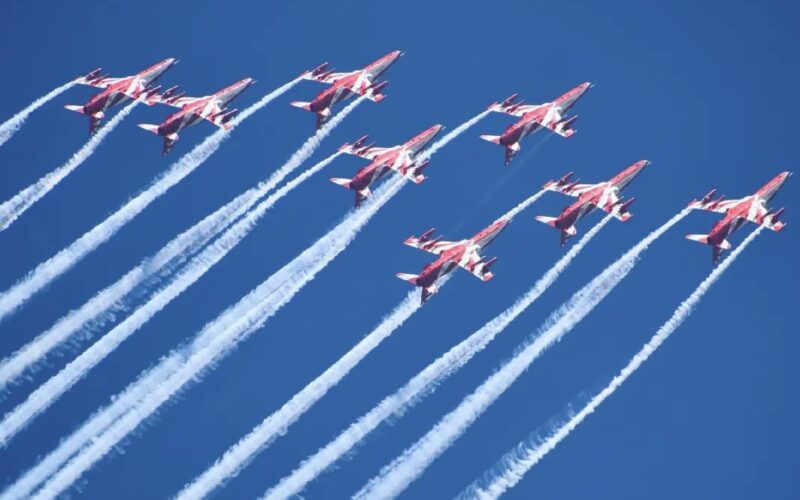Airshows often feature breakthrough technologies, lucrative aircraft deals, airplane displays, and interesting discussions on the issues affecting the aviation industry.
Aero India 2023 should be no exception. The 14th edition of Asia’s largest airshow brings together key players in the space, aviation, and defense industries. It will take place between February 13 and 17, 2023, at Air Force Station Yelahanka in Bengaluru.
More than 100 foreign and 700 Indian companies will showcase their products and services from across the world. Exhibitors include Airbus, Boeing, Dassault Aviation, Lockheed Martin, Israel Aerospace Industry, Hindustan Aeronautics Limited (HAL), and United Aircraft Corporation (UAC).
This year, India hopes to emphasize on the strategic growth of its industrial capabilities, which materialized with the Atmanirbhar Bharat initiative of the Prime Minister of India, Narendra Modi.
“Bengaluru sky is bearing testimony to the capabilities of New India,” Modi said on the opening day of the airshow. “Today, Aero India is India’s strength and not just a show.”
So, with India becoming one of the leading aviation markets, what can we expect to see at this exciting aviation event? And what should we be on the lookout for? AeroTime takes a closer look at this year’s line-up.
Airbus and Boeing caught in an Indian standoff
CAPA’s Indian division forecasts that Indian air carriers will order between 1,500 and 1,700 airliners by 2025. The country’s two main airlines are both poised to place historical orders with Boeing and Airbus.
Since its recent privatization, Air India has been mulling a sizeable order that would revamp its fleet. After reports that it was considering as many as 500 new aircraft from Airbus and Boeing, it is said that the carrier is in the final stages of finalizing an agreement with Boeing for an order of up to 220 aircraft, namely 190 737 MAX, 20 787, and 10 777X aircraft. Another order for 250 Airbus aircraft, of which 210 will be A320neo single-aisle and 40 A350 twin-aisle airliners, is also being considered. An official announcement could be made in the coming days.
IndiGo is expected to play catch-up with its competitor, CAPA India reported. India’s largest carrier would once again turn to Airbus and place an order for 500 aircraft.
India’s favorite, the Dassault Rafale
Dassault Aviation will attend both as a military and civilian manufacturer. The French planemaker will exhibit a front section of Falcon 2000 produced by a Franco-Indian factory located in Nagpur, central India. A Falcon 8X will also be on display.
But most importantly, Dassault will showcase two Rafale fighter jets: a Rafale C in the colors of the IAF, which already operates the aircraft, and a carrier-capable Rafale Marine.
The latter is being considered to replace the MiG-29K fighter of India’s naval aviation in the framework of the Multi-Role Carrier Borne Fighter (MRCBF) program. Pitched against the Boeing F/A-18 Super Hornet, it was recently revealed as the competition’s favorite.
Dassault has its eyes set on another important contract: the Multi-Role Combat Aircraft (MRCA), in which India is considering the acquisition of 114 new fighters for the IAF.
Other competitors in the MRCA tender, namely the Saab JAS-39 Gripen, Boeing’s F-15EX and F/A-18 Super Hornet, as well as Lockheed Martin’s F-21. While the name might be reminiscent of the F-22 Raptor, also manufactured by Lockheed Martin, the F-21 is in fact an F-16V “Viper” adapted to the needs of the IAF, which was unveiled during the 2019 edition of Aero India.
Checkmate and the Su-57E: the next generation of Russian fighters
The Russian state-owned defense conglomerate Rostec made headlines ahead of the airshow when it announced that a formal offer would be made to the Indian authorities to join the Su-75 Light Tactical Aircraft “Checkmate” program.
Since it was unveiled at the MAKS-2021 airshow, the Checkmate was marketed as a lighter, more affordable (and non-US…) alternative to existing fifth-generation fighter jets, mainly for Asian, Middle Eastern, African, European, and Latin American states customers.
But it will not be the sole Russian fifth-generation fighter on display. The Su-57E multirole fighter, the export variant of the Su-57 Felon, will also be showcased.
Russia has long been attempting to market its main fifth-generation fighter to India. It even materialized in 2007 when Sukhoi and Hindustan Aeronautics Limited jointly explored the development of a derivative of the Su-57 that would fit the needs of the Indian Air Force (IAF). Called the Fifth Generation Fighter Aircraft (FGFA) in India, it was eventually abandoned in 2018 over workshare and cost concerns. Will Russia’s United Aircraft Corporation attempt to rekindle India’s interest?

